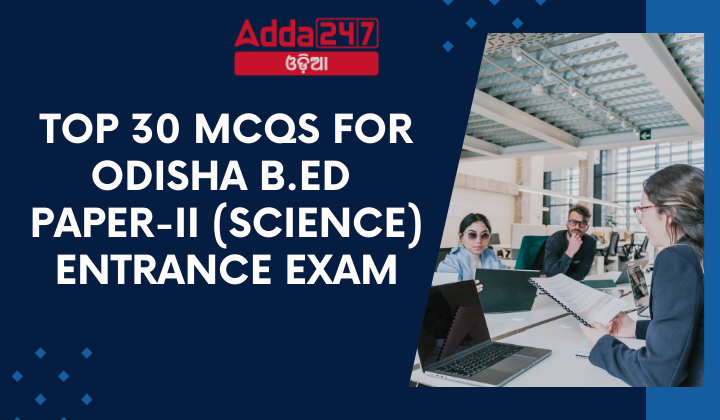Preparing for the Odisha B.Ed entrance exam can be challenging, especially for the Science section of Paper-II. To aid your preparation, we have compiled the top 30 multiple-choice questions (MCQs) that cover a broad range of topics essential for the exam. Each question is designed to test your knowledge and understanding of key scientific concepts.
Top 30 MCQs For Odisha B.Ed paper-II (Science) Entrance Exam
- Which formula is used to find compound ratios?
A) (a + c) : (b + d)
B) (a – c) : (b – d)
C) (a + b) : (a – b)
D) (a – b) : b
ANS:- A) (a + c) : (b + d)
Sol:- The formula used to find compound ratios is (a + c) : (b + d), where “a:b” and “c:d” are two given ratios. This formula is applied when two ratios are multiplied to obtain a compound ratio. So the correct answer is A) (a + c) : (b + d) - Q2. In which type of proportion, does an increase in one quantity result in a proportional decrease in the other?
A) Direct Proportion
B) Inverse Proportion
C) Continued Proportion
D) Compound Proportion
ANS:- B) Inverse Proportion
Sol:- In inverse proportion, an increase in one quantity results in a proportional decrease in the other, and vice versa. This means that as one quantity increases, the other quantity decreases proportionally, and vice versa. So the correct answer is B) Inverse Proportion - What is the formula for the surface area of a cuboid?
A) a √3
B) a³
C) 6a²
D) 2πr²
ANS:- C) 6a²
Sol:- The formula for the surface area of a cuboid is calculated by finding the sum of the areas of all its faces. Since a cuboid has 6 faces, each with an area equal to the product of its length and breadth, the total surface area A can be calculated as:
A = 2 (lw + wh + lh)
where l, w, and h represent the length, width, and height of the cuboid respectively. Simplifying this formula, we get:
A = 2lw + 2wh + 2lh
A = 2 (lw + wh + lh)
In a cuboid, opposite faces have the same area, so each term appears twice, leading to the simplified formula:
A = 2 (lw + wh + lh) = 2 × area of one face × 6
A = 6a².
Therefore, the correct answer is C) 6a². - Calculate the area of a rhombus with diagonals of lengths 10 cm and 12 cm.
A) 120 square cm
B) 60 square cm
C) 100 square cm
D) 150 square cm
ANS:- B) 60 square cm
Sol:- To calculate the area of a rhombus given the lengths of its diagonals, you can use the formula:
Area= ½ × Product of Diagonals
Given that the diagonals are 10 cm and 12 cm, the area can be calculated as:
Area = ½ × 10 × 12
Area = ½ × 120
Area = 60 square cm
Area = 60 square cm
So, the correct answer is B) 60 square cm - A flagpole casts a shadow of 10 meters when the angle of elevation of the sun is 45°. What is the height of the flagpole?
a) 5 √2 meters
b) 10 meters
c) 10 √2 meters
d) 20 meters
ANS:- 10 meters
Sol:- To find the height of the flagpole, we can use the trigonometric relationship between the height of the flagpole, the length of its shadow, and the angle of elevation of the sun.
Let h be the height of the flagpole, and s be the length of its shadow.
Given that the angle of elevation of the sun is 45∘, we can use the tangent function:
tan(45∘) = h/ s
Since tan(45∘) = 1, we have:
1 = h/ 10
Multiplying both sides by 10, we get:
h = 10
So, the height of the flagpole is 10 meters, which matches option b) 10 meters - What is the line drawn from the observer’s eye to the point on the object being observed called?
a) Horizon
b) Angle of elevation
c) Line of sight
d) Perpendicular line
ANS:- c) Line of sight
Sol:- The line of sight is the line drawn from the observer’s eye to the point on the object being observed. So, the correct answer is c) Line of sight - A flagpole casts a shadow of 10 meters when the angle of elevation of the sun is 45°. What is the height of the flagpole?
a) 5 √2 meters
b) 10 meters
c) 10 √2 meters
d) 20 meters
S3. ANS:- 10 meters
Sol:- To find the height of the flagpole, we can use the trigonometric relationship between the height of the flagpole, the length of its shadow, and the angle of elevation of the sun.
Let h be the height of the flagpole, and s be the length of its shadow.
Given that the angle of elevation of the sun is 45∘, we can use the tangent function:
tan(45∘) = h/ s
Since tan(45∘) = 1, we have:
1 = h/ 10
Multiplying both sides by 10, we get:
h = 10
So, the height of the flagpole is 10 meters, which matches option b) 10 meters - What is the line drawn from the observer’s eye to the point on the object being observed called?
a) Horizon
b) Angle of elevation
c) Line of sight
d) Perpendicular line
S4. ANS:- c) Line of sight
Sol:- The line of sight is the line drawn from the observer’s eye to the point on the object being observed. So, the correct answer is c) Line of sight - In trigonometry, what does the angle of elevation represent?
a) Angle between two perpendicular lines
b) Angle formed between the horizontal line and the line of sight to an object above the observer’s level
c) Angle formed between the observer and the object
d) Angle between the observer’s eye and the object
ANS:- b) Angle formed between the horizontal line and the line of sight to an object above the observer’s level
Sol:- The angle of elevation in trigonometry represents the angle formed between the horizontal line and the line of sight to an object above the observer’s level. So, the correct answer is b) Angle formed between the horizontal line and the line of sight to an object above the observer’s level - Which field extensively applies trigonometry in analyzing height and distance?
a) Biology
b) Architecture
c) Literature
d) Sociology
ANS:- b) Architecture
Sol:- Architecture extensively uses trigonometry to calculate heights, distances, and angles for designing structures. - What is the primary source of energy for photosynthesis in plants?
A) Glucose
B) Oxygen
C) Sunlight
D) Water
Answer: C) Sunlight
Explanation: Sunlight is the primary source of energy for photosynthesis. It is absorbed by chlorophyll pigments in chloroplasts to drive the biochemical reactions of photosynthesis. - Which organelle is primarily responsible for photosynthesis in plant cells?
A) Nucleus
B) Mitochondria
C) Chloroplasts
D) Endoplasmic reticulum
Answer: C) Chloroplasts
Explanation: Photosynthesis primarily occurs in chloroplasts, where chlorophyll pigments capture light energy and convert it into chemical energy. - During photosynthesis, what gas is released as a byproduct into the atmosphere?
A) Carbon dioxide
B) Oxygen
C) Hydrogen
D) Nitrogen
Answer: B) Oxygen
Explanation: Oxygen is produced as a byproduct of photosynthesis when water molecules are split during the light-dependent reactions. - Which of the following is NOT mentioned as a consequence of the rapid expansion of the human population?
A) Increased demand for essential resources
B) Heightened levels of pollution
C) Decreased strain on natural resources
D) Surge in demand for food, water, and shelter
Answer: C) Decreased strain on natural resources
Explanation: The passage discusses how the rapid expansion of the human population has led to increased demands for essential resources, heightened levels of pollution, and a surge in demand for food, water, shelter, and other goods. However, it does not mention any decrease in strain on natural resources. - Which of the following is NOT considered a resource in high demand due to population growth?
A) Energy
B) Transportation
C) Healthcare
D) Shelter
Answer: C) Healthcare
Explanation: The passage mentions increased demands for essential resources such as food, water, shelter, energy, transportation, and various other goods due to the rapid expansion of the human population. While healthcare may be indirectly affected by population growth, it is not explicitly mentioned as a resource in high demand. - What year was the Environment (Protection) Act enacted in India?
A) 1981
B) 1986
C) 1987
D) 1990
Answer: B) 1986
Explanation: The passage states that the Government of India enacted the Environment (Protection) Act in 1986 to safeguard and enhance the quality of the environment, including air, water, and soil. - What are the biotic components of an ecosystem?
a) Air, water, soil
b) Producers, consumers, decomposers
c) Sunlight, temperature, humidity
d) Rocks, minerals, nutrients
Answer: b) Producers, consumers, decomposers
Explanation: Biotic components of an ecosystem consist of living organisms, including producers (plants), consumers (animals), and decomposers (fungi, bacteria). - What is the primary source of energy for most ecosystems?
a) Soil nutrients
b) Fossil fuels
c) Sunlight
d) Air
Answer: c) Sunlight
Explanation: Sunlight serves as the primary source of energy for ecosystems, driving photosynthesis in plants and subsequently supporting the entire food web. - Which process involves the breakdown of complex organic compounds into simpler forms by decomposers?
a) Photosynthesis
b) Decomposition
c) Respiration
d) Digestion
Answer: b) Decomposition
Explanation: Decomposition is the process by which decomposers break down complex organic compounds from dead organisms and waste materials into simpler forms like carbon dioxide and water. - What is the term for the total biomass production by producers in an ecosystem?
a) Gross primary productivity (GPP)
b) Net primary productivity (NPP)
c) Secondary productivity
d) Tertiary productivity
Answer: a) Gross primary productivity (GPP) - What is the fundamental property of matter associated with the presence of electric charge?
(a) Mass
(b) Density
(c) Volume
(d) Electric Charge
Answer: (d) Electric Charge
Explanation: Electric charge is a fundamental property of matter. - What is the unit of electric current?
(a) Volts
(b) Ohms
(c) Amperes
(d) Watts
Answer: (c) Amperes
Explanation: Electric current is measured in amperes (A). - Which component of an electric circuit stores electrical energy in the form of a magnetic field?
(a) Resistor
(b) Capacitor
(c) Inductor
(d) Transformer
Answer: (c) Inductor
Explanation: An inductor stores electrical energy in the form of a magnetic field. - What serves as a fixed point for measuring distances and displacements?
(A) Speed
(B) Reference point
(C) Velocity
(D) Acceleration
Answer: (B) Reference point
Explanation: A reference point serves as a fixed location from which distances and displacements are measured. - What is the difference between distance and displacement?
(A) Distance is a scalar quantity, while displacement is a vector quantity
(B) Displacement is a scalar quantity, while distance is a vector quantity.
(C) They are both scalar quantities
(D) They are both vector quantities
Answer: (A) Distance is a scalar quantity, while displacement is a vector quantity.
Explanation: Distance only has magnitude, while displacement has both magnitude and direction. - Which of the following units is used to measure speed in the International System of Units (SI)?
(A) Kilometers
(B) Meters per second (m/s)
(C) Miles per hour (mph)
(D) Feet per second (fps)
Answer: (B) Meters per second (m/s)
Explanation: Speed is commonly measured in meters per second in the SI system. - Which of the following statements about sound is true?
(a) Sound travels faster in vacuum than in air.
(b) Sound can only travel through solids.
(c) Sound is a form of electromagnetic radiation.
(d) Sound requires a medium to propagate.
Answer: (d) Sound requires a medium to propagate.Explanation: Sound waves are mechanical waves that require a medium (such as air, water, or solids) to propagate.
They cannot travel through a vacuum. - What type of wave are sound waves?
(a) Transverse waves
(b) Electromagnetic waves
(c) Longitudinal waves
(d) Standing waves
Answer: (c) Longitudinal waves
Explanation: Sound waves are longitudinal waves, where the particles of the medium oscillate parallel to the direction of wave propagation. - Which property of sound determines its pitch?
(a) Amplitude
(b) Wavelength
(c) Frequency
(d) Speed
Answer: (c) Frequency
Explanation: The pitch of sound is determined by its frequency. Higher frequencies correspond to higher pitches, while lower frequencies correspond to lower pitches. - Which mirror type is commonly used in security mirrors in stores?
(a) Concave mirror
(b) Convex mirror
(c) Plane mirror
(d) Spherical mirror
Answer: (b) Convex mirror
Explanation: Convex mirrors are used in security mirrors to provide a wide-angle view of the surroundings.










